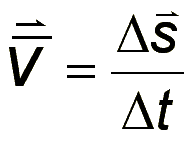The formula for velocity is one of the first that you learn in physics. It is also one of the most important as it is help to solve more complex physic problems and give comprehension of other physics concepts. However it is one that can be easily misunderstood. We too often mistake speed and velocity to be the same. As we know it the formula simply states that velocity is rate of the change in position or distance over time. The problem is that this can also be applied to speed. However speed and velocity are to different concepts even though they share the same formula.
The first thing that sets velocity apart is that it is what is called a vector. A vector is a quantity that has both a numerical magnitude or value and a direction. Physics involving velocity needs these two components to work properly. Speed only has magnitude and no direction.
The next thing is that velocity can have a positive or negative value. This most times has to do with the direction of the object in its particular reference frame. This is because physics breaks down motion on the large scale from the point of view of an observer. Speed is different in that is relative to whatever circumstance it is applied to.
Finally velocity can vary over time. Derivations of the formula for velocity like the formula for final velocity take this into account taking an intial and final velocity to determine the overall velocity of an object. Speed only has one situation and that is instantaneous velocity or the speed that occurs at a given moment.
The formula for velocity is one of the key concepts of physics. Without it we can’t understand classical mechanics and even the motion of particles and massive planets and galaxies. For this reason it is important for any physics lover to understand how it works and should be applied.
If you enjoyed this article there are several others on Universe Today that you will find interesting. There is a great article about Newton’s laws of motion. There is also an interesting article on Planck’s constant.
You can also find some great resources online. There is a great explanation of velocity on the GSU.edu hyperphysics web site. You should also watch the video about motion on howstuffworks.com.
You can also listen Astronomy Cast. Episode 44 is about Einstein’s theory of general relativity.
Sources:
The Physics Classroom
Engineering Toolbox

